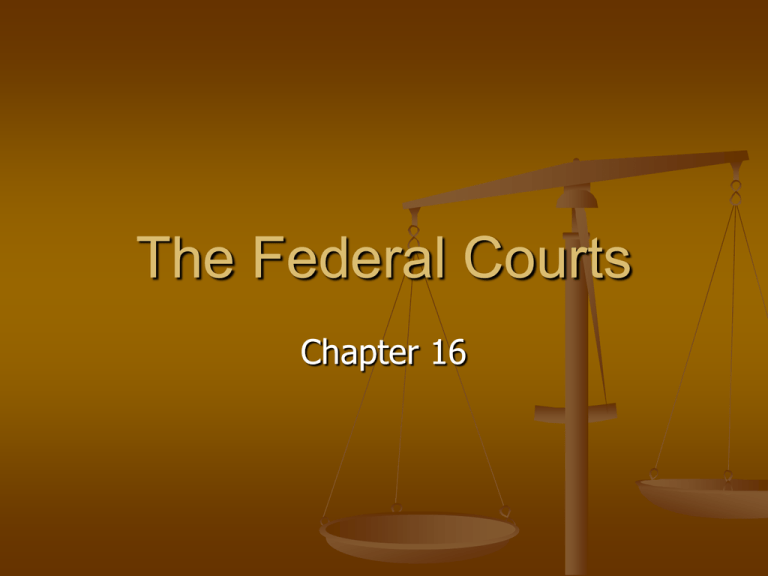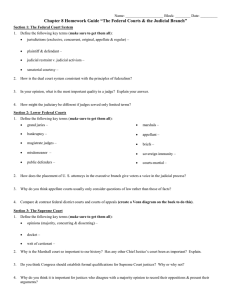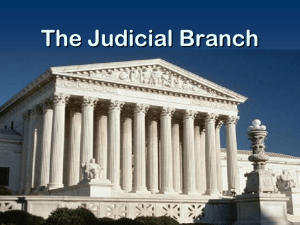The Federal Courts Chapter 16
advertisement

The Federal Courts Chapter 16 The Adversarial System The Courts provide an arena for two parties to bring their conflict to an impartial arbiter. Criminal Law Cases- the government charges an individual with violating specific laws Involve grand juries and trial juries Civil Law Cases- a dispute between two parties where one claims to have been “wronged” by the other Civil law cases often involve a “tort.” Civil law cases do not decide guilt or innocence, but whether or not monetary compensation is justified. Participants in the Judicial System Litigants- the two parties involved Plaintiff- person who brings the suit Plaintiffs must have “standing to sue.” Defendant- person who is being sued Judges- judicial power is “passive.” Judges cannot actively seek out cases; they must wait for cases to be brought to them Disputes must be “justiciable,” meaning they must be able to be decided by legal methods or knowledge Participants, continued… Outside Groups- groups often seek out litigants whose cases seem likely to warrant court attention and result in broad statements about civil liberties or public policy. (Examples: ACLU, NAACP) Class Action Lawsuits- a small number of people may sue on behalf of those similarly situated. Lawyers In many criminal cases, the defendant is too poor to afford an attorney so they are appointed one by the state- these are referred to as public defenders. Solicitor General- lawyer for the U.S., argues cases before the Supreme Court when the U.S. is a litigant The Structure of the Federal Judiciary Federal District Courts 91 Judges and Juries original jurisdiction appellate jurisdiction in death penalty cases from states Employ the U.S. Attorneys and the U.S. Marshalls The Structure of the Federal Judiciary, cont… The Circuit Courts of Appeal 12 Anywhere from 6-27 judges, no juries Decide cases in panels of 3, but may sit en banc Only appellate jurisdiction The Supreme Court 1 9 judges, no juries The number of justices on the Supreme Court is set by Congress. original and appellate jurisdiction The Politics of Judicial Selection Presidents can have long lasting effects more so through court appointments than almost anything else. The Lower Federal Courts- many entities have input. The President through the Justice Department The Senate- Senatorial Courtesy and Confirmation The American Bar Association- ratings system The Supreme Court- appointments have become highly political in recent years. Historically, only 29 of 151 nominees have not been confirmed. The Politics of Judicial Selection, cont… Recent Controversies: Robert Bork 1987- Justice Kennedy finally confirmed. Clarence Thomas- 1991- Anita Hill hearings Ruth Bader Ginsburg- 1993- Clinton wavered until last second nomination Harriet Miers- 2005- withdrew her nomination after a firestorm of opposition from the right. And, here they are… The Current Court A Historical Review of the Courts 1789-early 1900s- the growth of national supremacy and judicial review. Two notable instances where the court’s prestige was weakened Cherokee Nation v. Georgia (1832) and Dred Scot v. Sanford (1857) The Nine Old Men- conservative judges during the New Deal struck down program after program as unconstitutional FDR and the Court Packing scheme Historical Review, cont… The Warren Court (1953-1969)- the highwater mark of liberal activism The Burger Court (1969-1986)- more conservative leaning, with some notable exceptions- Roe v. Wade, NY Times v U.S. The Rehnquist Court (1986-2005)- often known as the “states rights” court, except for one glaring exception- Bush v. Gore The Roberts Court (2005-)- most noted so far for taking extremely technical cases that rule on narrow points of law, but we’ll see… The Nature of Judicial Power and Philosophy of Judges Original Intent- a.k.a. strict constructionismbelieve founders intent should be paramount in interpreting the Constitution Loose Constructionismbelieve Constitution should be interpreted to fit contemporary needs and situations Judicial Activism- Judges make bold policy decisions, chart new Constitutional ground, overturn precedents and do not hesitate to overturn the policymaking decisions of Congress and the President Judicial Restraint- judges adhere to precedent and minimally overturn the policymaking decisions of Congress and the President What is the assumption? That “conservative” judges always believe in strict constructionism and judicial restraint, and that “liberal” judges always believe in loose constructionism and judicial activism. Although this is partially true, the reality is far more complicated. These terms are mainly used today by both sides to rile up discontent over judicial decisions and judicial nominees. Example: New Deal- conservative judges were “activist” by overturning policy made by Congress based on a “strict” interpretation of the commerce clause. Summary The unelected and powerful federal courts raise important questions about democracy and the scope of judicial power. Yet court decisions are usually consistent with public opinion and justices often use their power to protect those rendered powerless by majoritarian democracy. The role of the courts as active policymakers or restrained adherents to original intent will remain a matter of continued debate as the interest groups continues to use the courts to push their own policy agendas. How cases reach the Supreme Court Step 1: Litigant files for a writ of certiorari- a formal order used to bring a case to court The decision to “grant cert” is based on the rule of four- if four justices want to review the case, then it will be granted cert. The court gets an average of 1500-2000 cert petitions per year, and grants less than 10% Potentially, the Supreme Court will deny cert, but remand the case back to the lower court. Step 2: Once cert has been granted, the case is put on the docket- the formal schedule of cases to be heard during that term (Oct-June) At this time, both parties begin submitting briefs - written summaries of the legal arguments for both sides. Interested outside parties can also submit briefsthese are called amicus curiae (or, friend of the court) briefs. Step 3: Law clerks review the briefs and present summaries of the cases to the justices. The law clerk role is very important- not only do they review all cert petitions, but they also prepare information for the justices on the cases they will actually “hear.” Each justice has 3 clerks, except for the chief, who gets 4. Once the clerks prepare summaries, the justices review all the relevant information. Step 4: Oral Arguments: This is the only part of the process open to the public/media. NO CAMERAS Each lawyer gets 30 minutes to present their case to the justices, at which time the justices can interrupt with questions, etc… This is where the media pays attention to try to get a feel for how each justice is leaning. Step 5: Conference- one or two days per week, the justices meet in secret to discuss the cases they’ve recently heard. At this time, they take a preliminary vote and decide who will write the opinions in the case. Step 6: The Opinions- what did they decide? The Majority Opinion- this becomes the precedentthe settled law by which all future cases are decided. Who writes it? If the chief is in the majority, he decides. If the chief is in the minority, the ranking justice in the majority decides. Why is this significant? The opinion sets the “tone” and contains important language. (i.e. Sandra Day O’Connor and undue burden The Dissenting Opinion- this is important as it can potentially become the reason to overturn precedent. Plessey v. Ferguson had one dissenting opinion. The Concurring Opinion- the opinion of those agreeing with majority, but for different legal reasons.







